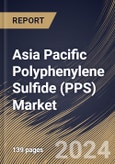The Asia Pacific Polyphenylene Sulfide (PPS) Market would witness market growth of 8.9% CAGR during the forecast period (2023-2030). In the year 2021, the Asia Pacific market's volume surged to 1,053.09 Hundred Tonnes, showcasing a growth of 6.9% (2019-2022).
As industries explore lightweighting strategies, PPS foam innovations gain prominence. With their low density and high strength, PPS foams offer a compelling solution for applications where weight reduction is critical. In particular, the automotive and aerospace sectors benefit from PPS foams in components where a balance between weight savings and structural integrity is paramount. Innovations in PPS foam formulations contribute to the expansion of its application horizons.
Moreover, using PPS with other polymers in blends and alloys signifies a frontier of exploration. Blends with polyphenylene ether (PPE), polyetherimide (PEI), or other high-performance polymers result in materials with unique combinations of properties. These PPS blends and alloys cater to specific application requirements, offering a tailored approach to meet the diverse needs of electronics, automotive, and industrial manufacturing industries.
With the growing emphasis on electric vehicles (EVs) globally, including India, there is an increased demand for materials that meet the specific requirements of electric drivetrains. With its electrical insulating properties and resistance to high temperatures, PPS could find applications in components like connectors, insulators, and other electrical parts within EVs. Additionally, as per the data released by the International Trade Administration in 2023, China continues to hold its position as the worldwide leader in both annual vehicle sales and manufacturing output, and it is projected that domestic production will reach 35 million vehicles by 2025. Hence, the rising electronics and automotive sectors in the Asia Pacific will help in the expansion of the regional market.
The China market dominated the Asia Pacific Polyphenylene Sulfide (PPS) Market by Country in 2022, and would continue to be a dominant market till 2030; thereby, achieving a market value of $285.6 Million by 2030. The Japan market is registering a CAGR of 8.2% during (2023 - 2030). Additionally, The India market would showcase a CAGR of 9.6% during (2023 - 2030).
Based on Type, the market is segmented into Linear PPS, Cured PPS, and Branched PPS. Based on Application, the market is segmented into Automotive, Electrical & Electronics, Industrial, Aerospace, Medical/Healthcare, and Others. Based on countries, the market is segmented into China, Japan, India, South Korea, Singapore, Malaysia, and Rest of Asia Pacific.
As industries explore lightweighting strategies, PPS foam innovations gain prominence. With their low density and high strength, PPS foams offer a compelling solution for applications where weight reduction is critical. In particular, the automotive and aerospace sectors benefit from PPS foams in components where a balance between weight savings and structural integrity is paramount. Innovations in PPS foam formulations contribute to the expansion of its application horizons.
Moreover, using PPS with other polymers in blends and alloys signifies a frontier of exploration. Blends with polyphenylene ether (PPE), polyetherimide (PEI), or other high-performance polymers result in materials with unique combinations of properties. These PPS blends and alloys cater to specific application requirements, offering a tailored approach to meet the diverse needs of electronics, automotive, and industrial manufacturing industries.
With the growing emphasis on electric vehicles (EVs) globally, including India, there is an increased demand for materials that meet the specific requirements of electric drivetrains. With its electrical insulating properties and resistance to high temperatures, PPS could find applications in components like connectors, insulators, and other electrical parts within EVs. Additionally, as per the data released by the International Trade Administration in 2023, China continues to hold its position as the worldwide leader in both annual vehicle sales and manufacturing output, and it is projected that domestic production will reach 35 million vehicles by 2025. Hence, the rising electronics and automotive sectors in the Asia Pacific will help in the expansion of the regional market.
The China market dominated the Asia Pacific Polyphenylene Sulfide (PPS) Market by Country in 2022, and would continue to be a dominant market till 2030; thereby, achieving a market value of $285.6 Million by 2030. The Japan market is registering a CAGR of 8.2% during (2023 - 2030). Additionally, The India market would showcase a CAGR of 9.6% during (2023 - 2030).
Based on Type, the market is segmented into Linear PPS, Cured PPS, and Branched PPS. Based on Application, the market is segmented into Automotive, Electrical & Electronics, Industrial, Aerospace, Medical/Healthcare, and Others. Based on countries, the market is segmented into China, Japan, India, South Korea, Singapore, Malaysia, and Rest of Asia Pacific.
List of Key Companies Profiled
- Solvay SA
- Toray Industries, Inc.
- Celanese Corporation
- SABIC (Saudi Arabian Oil Company)
- Tosoh Corporation
- DIC Corporation
- SK chemicals
- Kureha Corporation
- Teijin Limited
- RTP Company, Inc.
Market Report Segmentation
By Type (Volume, Hundred Tonnes, USD Billion, 2019-30)- Linear PPS
- Cured PPS
- Branched PPS
- Automotive
- Electrical & Electronics
- Industrial
- Aerospace
- Medical/Healthcare
- Others
- China
- Japan
- India
- South Korea
- Singapore
- Malaysia
- Rest of Asia Pacific
Table of Contents
Chapter 1. Market Scope & Methodology
Chapter 2. Market at a Glance
Chapter 3. Market Overview
Chapter 5. Asia Pacific Polyphenylene Sulfide (PPS) Market by Type
Chapter 6. Asia Pacific Polyphenylene Sulfide (PPS) Market by Application
Chapter 7. Asia Pacific Polyphenylene Sulfide (PPS) Market by Country
Chapter 8. Company Profiles
Companies Mentioned
- Solvay SA
- Toray Industries, Inc.
- Celanese Corporation
- SABIC (Saudi Arabian Oil Company)
- Tosoh Corporation
- DIC Corporation
- SK chemicals
- Kureha Corporation
- Teijin Limited
- RTP Company, Inc.
Methodology

LOADING...








